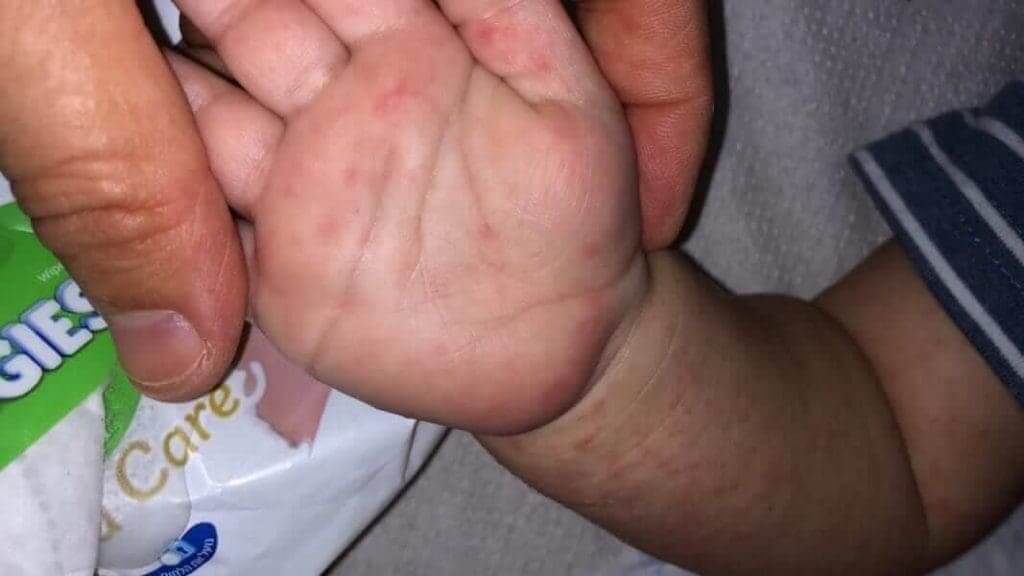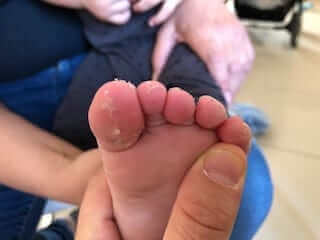
Enterovirus – hand, foot and mouth disease
A virus, or more accurately – a family of viruses that cause so many disease in children, and so much confusion in terminology and manifestations, that I was bound to have a post about it.
First, so we can speak in the same language, some definitions:
– Enteroviruses – a family of viruses that cause a diverse morbidity in children. Amongst other – hand, foot and mouth disease.
– Hand, foot and mouth disease – a disease caused by specific strains of enteroviruses.
– Foot and mouth disease – a viral infection that attacks different animals, and is caused by a totally different virus called foot and mouth disease virus, which is not a member of the enteroviruses family.
Let’s continue.
Enterovirus family? What family?
Enteroviruses family is a name that includes inside a lot of strains and species. In this family you can also find the poliovirus, for which there is a vaccine. Amongst the enteroviruses there are other subgroups –
– Coxsackievirus type A: with additional division into subgroups.
– Coxsackievirus type B: with additional division into subgroups.
– Echovirus
– Enterovirus with division into subgroups (named with numbers and letters, there are over a 100 strains).
The importance of the different strains and sub-divisions will be explained later ahead.
What does enterovirus do?
A lot of different diseases, in children and adults.
From common infections such as: the common cold, mild pharyngitis and conjunctivitis, and up to central nervous system involvement such as encephalitis. It can also cause infection in the intestines (including vomiting and diarrhea), myocarditis (infection of the cardiac muscle), and life-threatening infections in babies in the first week of life.
In fact, these viruses can be involved and affect every system in our body. Though it can cause severe and dangerous infections, milder forms of infections are far more common.
So what will determine which type of disease will occur?
This is in fact a combination of the virus strain and the degree of immunity the child has against it.
For example, enterovirus #71 is one of the causes for hand, foot and mouth disease. On the other hand, under certain circumstances and some bad luck it can cause a more severe disease with brain involvement.
On the other hand, coxsackievirus type A (strains 6+16) can also cause hand, foot and mouth disease, with a more prominent rash from the one that is caused by the classic enterovirus #71.
Another example is coxsackievirus type a #24 and enterovirus #70, which causes typical conjunctivitis.
Practically, the strain of the virus is not that important (and also not recognizable). The doctor will be satisfied with a general diagnosis of “enterovirus infection”.
Those of you who encountered other strains of enteroviruses in the past will usually have a milder form of the disease, as opposed to those who encounter the virus for the very first time. This explains why most of the patients who contract hand, foot and mouth disease are children, and not adults.
There is too much to say about all the different disease caused by enteroviruses, so I will now focus on hand, foot and mouth disease.
What exactly is hand, foot and mouth disease?
A specific form of enterovirus infection including different strains of the virus. In its classical form there are typical lesions in the oral cavity and a typical rash. In the more severe disease there can be high fever for 4-5 days (in the more mild disease there is no fever). The rash is typical and involves the palms of the feet and hands. The lesions can be anything from small and red to large diffuse blisters (see picture 1+2). Children with dry and atopic skin or children who contracted one of the more violent strains of the disease will have a more significant and diffuse rash.
The oral lesions can cause inconvenience to the child, excessive drooling and pain. Sometimes you will find lesions outside the mouth, causes by virions (the part of the virus that causes the spreading of the virus), in the saliva that drools on the skin around the mouth (picture 3). Sometimes after the healing phase the skin in the tips of the hands and feets will peel off.
It is worth mentioning that in some cases of hand, foot and mouth disease, especially in children who already contracted enterovirus infections in the past and present some immunity against them, the disease can be milder (meaning very few findings in physical examination( if any at all) in the oral cavity and an unidentifiable rash).
Is hand, foot and mouth a contagious disease?
Certainly. When I see an infant with enterovirus infection, I know he will not be the only case in his kindergarten. Outbreaks are common.
The virus passes from one person to another by contracting with secretions from a sick individual to a healthy one. Secretions can be of the respiratory system (saliva for example) or gastrointestinal system (stools). Incubation period is 3-6 days.
When a child is sick, his little brothers and sisters are at risk to contract a similar infection. Contracting the virus from inside the family can be avoided with proper hygiene and preventing touch with secretions.
You should also know that the patient can secret the virus in his respiratory and gastrointestinal system for several weeks after recovering from the virus (1-3 in the respiratory system and 7-11 week in the stools). This is one of the reasons it is hard to control out brakes.
How will the disease be diagnosed?
The diagnosis of hand, foot and mouth disease is based on clinical manifestations and typical findings in physical examination. Mostly there is no need for more sophisticated tests. A more specific diagnosis with the name or strain of the virus is unnecessary.
There is special attention for differentiating the lesions in the oral cavity from this virus to another (herpes for example). In herpetic infection there will be no rash in the sole of the feet and hands. Please read the following link in order to see you did not miss herpes infection.
Is there a specific treatment for the disease?
Unfortunately no. treatment is supportive care for lowering the fever and relieving pain. Treatment should also include proper hydration. You should try to give the child lots of fluids (in some cases slowly, even with a syringe directly into the mouth), especially in children with a lot of lesions in their mouth. Children can eat whatever they want as long as it will not cause any pain.
The skin lesions are uncomplicated and will not leave any scars.
Goat milk or any other tricks? A lot of nonsense and I recommend you to not be tempted. The disease will pass on its own after 4 days, with or without goat milk straight from the goat.
Antibiotic treatment is not necessary except in cases where the physician will think about secondary infection (not common).
Are there any complications?
Although every possible complication was described after hand, foot and mouth disease (from secondary bacterial infection to brain involvement), most cases are complications free.

When can a child return to school?
In terms of the child – when he is feeling better and without any pain, and after at least 24 hours without fever – he can return to normal activity.
In terms of contagion for his surrounding – you need to wait at least 24 hours after the lesions in the mouths are gone and the drooling has stooped.
In conclusion, enterovirus is very common and causes significant diseases in children. Hand, foot and mouth disease is a specific disease caused by specific enterovirus strains. It is unpleasant but passes on its own without treatment or any complications.

For comments and questions, please register
